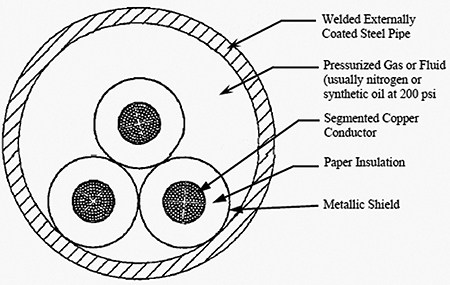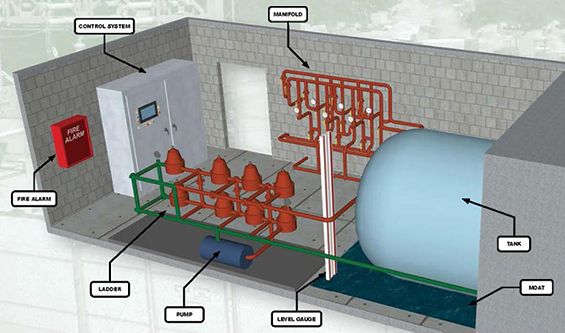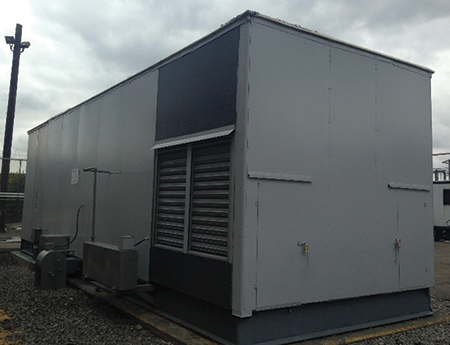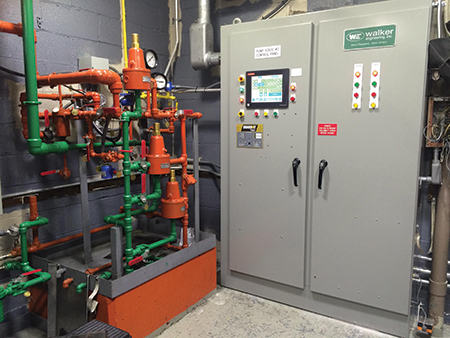There are approximately 4500 circuit miles of 69kv to 345kv underground transmission cables in service in the United States, most of which are High-Pressure Fluid-Filled (HPFF) cables. HPFF cable systems are complex durable systems, recognized for their reliability, however, as is the case with most complex systems – they are only as good as their weakest link. While the conductors have significant life left, much of the critical infrastructure supporting these cable systems is nearing end of life and decision makers at electric utilities must make a choice in how to address the aging components that support these HPFF cables. Targeted, surgical replacement of major components is cost effective methodology for modernizing and upgrading these HPFF systems.

HPFF Cables and Aging Ancillary Infrastructure
A HPFF pipe-type underground transmission line consists of a steel pipe containing three high-voltage conductors. The conductors are insulated with oil-impregnated kraft paper and covered with skid wires to reduce friction during installation. Within the pipe, the cables are then surrounded by dielectric fluid maintained at 200 psi to further insulate the cables. The dielectric fluid is regulated by external plants that maintain the needed pressure and ensure feeder health. Without the required dielectric fluid pressure, the insulating capabilities are compromised. Despite the increasing demand for solid dielectric cables the installed base of HPFF cables is so large that it remains the primary underground transmission cable in much of the county, in large part because of its reliability, superior ampacity and long service life – consistently exceeding that of its solid cousin. But while the cables themselves have an almost infinite life, much of the ancillary infrastructure supporting these HPFF systems are quickly reaching ‘old age.’ The most vital and often most neglected components of these intricate systems are Pressurizing Plants and Circulating/Cooling Plants.
Pressurizing Plants: HPFF cables require pressurization with dielectric fluid for everyday operation – this is accomplished using installations known as pressurizing plants. Commonly referred to as pumping plants or pump houses throughout the electric utility industry, pressurizing plants are critical to the performance of the feeder. If pressure is lost, the cable must immediately be de-energized to prevent damage, resulting in the loss of a transmission path. Often located in substations and housed in insulated enclosures, these plants include a reservoir tank that holds reserve fluid, hydraulic ladders and relief valves to maintain proper pressures, pressurizing pumps, alarms, monitors and controls

Circulating/Cooling Plants: In addition to pressurizing the fluid, a feeder can have a circulating or cooling plant to help augment cable ratings. Circulating the fluid that insulates the cables helps remove hot spots which in turn increases capacity. Circulating plants can be upgraded beyond circulation to include forced air cooling and refrigeration. Forced air cooling and refrigeration are popular options to increase ratings of HPFF cables while using existing infrastructure.

Pressurizing plants commissioned in the 60’s and 70’s, while still operable, are reaching the end of their usable life-cycle and are not scalable to meet the needs of increasing demands. Bob Ryan is the president of Walker US, Inc., a pressurizing plant manufacturer in New Jersey. He recalls the first time he set foot in an aging plant during a substation walkthrough. “Our first inspection of pump houses and circulating plants left some wonderment as to how they were still in operation,” Bob Ryan said. “The truth is, equipment made in the 60’s and 70’s was made to last. The individual components however, were beginning to fail and difficult to repair in kind”.
When faced with the issue of component obsolescence, utilities have few options. The reliability requirements of these plants demand the highest quality parts. As these parts fail and no replacement is available, a new plant may seem the only viable option. However, installing a new plant is a costly proposition that often requires long duration transmission outages while also creating significant logistical problems. There is a more effective way to restore ‘like new’ operation to HPFF pressurizing, circulating and cooling plants: HPFF Equipment Restoration.
The Immediate and Long Term Benefits of Restoration
In most cases, the tanks, structures and much of the piping are still in excellent condition, restoring the plant to like new operational condition only requires that critical individual subsystems such as the controls, pumps and valves to be replaced.
Restoration of a pressuring plant is less expensive and requires a much shorter outage than the replacement. Oftentimes there are no permitting requirements and zero rigging needed to complete the project and is much more economical. A complete restoration is often less than one tenth the cost of a new installation which often exceeds one million dollars. Perhaps of greater importance than the cost savings associated with refurbishing a pressurizing plant is the considerably shorter downtime. Complete plant replacements require long outages which can be difficult to schedule and expensive, costing utilities millions and impacting service reliability. A complete restoration can be achieved in weeks while commissioning a new plant can often take up to six months. ‘Like new’ restorations can include improvements such as new pressurization ladders, pumps, manifold assemblies, controls, instruments, leak detection capabilities, and hydraulic components. “A sawzall, new instruments and a new control cabinet cures most of what ails these equipment structures.” Bob Ryan says. “Some restorations include modern oil level sensors, new pressure relief valves; even a complete ladder replacement. Old valves can also be replaced and repositioned. New heat, vents, lights and fire alarms are the finishing touches. At the end of a Walker restoration, the pump house or cooling plant looks and performs as new.”

Above: A typical retrofit ladder. A pump house ladder allows control of feeder
pressure through pressure relief valves, check valves and instrumentation.
The Preferred Choice
With the advantages that restoration provide, justifying the installation of a completely new plant is difficult. Restoration provides the functionality, scalability and technical advantages of a prefabricated plant, while reducing feeder downtime, being more ecological, and a providing a more cost effective solution.
- Reduced Feeder De-rate. Restorations provide the unique benefit of reducing de-rate times by allowing work to be done within the confines of the plant. It also prevents the need to de-energize overhead feeders to crane into place a new plant. Red tape is reduced due to the fewer permit requirements. Additionally, de-rate time can be reduced even further using a portable pump house. Leaving the existing infrastructure of the plant allows for external connection to a temporary pressurizing setup which can be used to place the feeder back into full service while the work is being performed. The time table for a complete plant replacement can be up to six months while a “like new” restoration can be realized in a matter of weeks.
- Fewer Permits. The installation of new plants requires a multitude of permits to satisfy city and state requirements. Using the existing structure and leaving in place select components of the plant reduces the need for many of these permits and allow for faster project completion and less delays.
- Ecologically Friendly. Restoration generally involves the re-use of the reservoir tank and piping that carries the dielectric fluid to the feeder. Re-using this equipment prevents unnecessary waste must be treated as hazardous.
- Material Cost Savings. Restoration focusses on the components that require attention and leave in place the ones that do not. The act of restoration not only saves money in terms of time but also replacement of materials.
Ultimately restoration provides a quick and cost effective solution that allows utilities to keep their feeders online longer, reducing cost and reducing waste. It also affords the opportunity to complete multiple restorations in the same timeframe and cost as installing a new plant.
Summary
Despite the advancements in solid dielectric cable technology, the installed base of HPFF cable represents the largest proportion of underground transmission cable in service in the United States. The simple fact is, a High-Pressure Fluid-Filled cable’s life is almost infinite, solid cables, on the other hand, often show signs of failure in less than 20 years. It is because of this incredible life cycle that much of the support equipment must be meticulously maintained and when needed, restored to “like new” operation. Given the option to replace or restore, Bob Ryan of Walker US feels it’s a simple decision. “It just makes sense. With the time and money saved, not to mention the aggravation, using restoration to improve reliability and modernize your HPFF system is a good solution for the short term and long run”.
About the Author
 Jillian Leinen is the owner and CEO of Walker US, a company that designs and manufactures solutions for electric utilities. She is responsible for running all facets of the business as well as managing high profile projects. Jillian joined Walker after graduating Villanova University with a BSE in chemical engineering. She quickly put her engineering expertise to use and successfully executed projects that have brought the company into the electric utility industry. Jillian succeeded Bob Ryan as CEO and became the majority shareholder of Walker US in 2016.
Jillian Leinen is the owner and CEO of Walker US, a company that designs and manufactures solutions for electric utilities. She is responsible for running all facets of the business as well as managing high profile projects. Jillian joined Walker after graduating Villanova University with a BSE in chemical engineering. She quickly put her engineering expertise to use and successfully executed projects that have brought the company into the electric utility industry. Jillian succeeded Bob Ryan as CEO and became the majority shareholder of Walker US in 2016.







